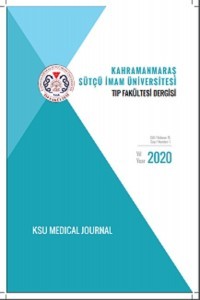TRAVMATİK ASFİKSLİ (PERTHES SENDROMU) HASTADA ANESTEZİ YÖNETİMİ
Travmatik asfiksi, Perthes sendromu, anestezi yönetimi
___
- 1- Jobe J, Ghuysen A, Hartstein G, D’orio V. A fatal case of Perthes syndrome. J Emerg Trauma Shock 2013;6: 296-297.
- 2- Çelik B, Öztürk D, Gürz S. Travmatik asfiksi. J Exp Clin Med 2012;29: 163-165.
- 3- Kılıçgün A. Travmatik asfiksi. JClin Anal Med 2010;361.
- 4- Esme H, Solak O, Yurumez Y, Ermis S, Yaman M, Fidan F. Perthes syndrome associated with bilateral optic disc edema. Can J Ophthalmol 2006;41: 780-782.
- 5- Kamali S, Kesici S, Gunduz I, Kesici U. A case of traumatic aspyxia due to motorcycle accident. Case Rep Emerg Med 2013; Article ID 857131: 3 pages.
- 6- Ertok İ, Çelik Kurtoğlu G, Haydar Ercan G, Karakayalı O, Yılmaz M, Erşen T. Review of traumatic asphyxia syndrome with a case presentation. J Academic Emerg Med 2013;4: 58-61.
- 7- Imai M, Hanaoka Y, Kemmotsu O. Valve injury: a new complication of internal jugular vein cannulation. Anesth Analg 1994;78: 1041-1046.
- 8- Gulbahar G, Kaplan T, Gundogdu AG, Baran HN, Kazanci B, Kocer B et al. A rare and serious syndrome that requires attention in energency service: Traumatic asphyxia. Case Rep Emerg Med 2015; Article ID 859814: 4 pages.
- 9- Olusina DB, Nzegwu A, Ezike K, Ighakwe OU. Traumatic asphyxia as a predominant cause of accidental deaths in autopsies of 10 people who died in a stampede from a religious gathering in Enugu. Int J Natural Sci 2011;2: 443-446.
- 10- Eren B, Türkmen N, Fedakar R. An unusual case of thorax compression. J Ayub Med Abbottabad 2008;20: 134-135.
- 11- Choi YJ, Lee SJ, Kim HJ, Yim JH. Bilateral retrobulbar hemorrhage and visual loss following traumatic asphyxia. Korean J Ophthalmol 2010;24: 380-383.
- 12- Eken C, Yıgıt O. Traumatic asphyxia: a rare syndrome in trauma patients. Int J Emerg Med 2009;2: 255-256.
- ISSN: 1303-6610
- Yayın Aralığı: Yılda 3 Sayı
- Başlangıç: 2004
- Yayıncı: Kahramanmaraş Sütçü İmam Üniversitesi
Neuromyelitis Optica and Neuromyelitis Optica Spectrum Disorders : Report of Nine Cases
Fatma KURTULUŞ, Aylin YAMAN, Burcu YÜKSEL, Yasemin BİÇER GÖMCELİ
Anonişi ile Seyreden Bir Liken Planus Olgusu
İsmet SEVİMLİ, Perihan ÖZTÜRK, Mehmet Kamil MÜLAYİM
TRAVMATİK ASFİKSLİ (PERTHES SENDROMU) HASTADA ANESTEZİ YÖNETİMİ
Bora Bilal, Nezir Yılmaz, Mahmut Arslan, Aykut Urfalıoğlu, Gökçe GİŞİ, Hüseyin YILDIZ, Hafize Öksüz, Selma Urfalıoğlu
Travmatik Sternum Fraktürleri ve Tedavisinde Deneyimlerimiz
Kahverengi Köpek Kenelerinin (Rhipicephalus sanguineus) Taksonomik Özelliklerinin Araştırılması
Ekrem KİREÇCİ, Metin Tansu UĞUZ
Murat BAYKARA, Özlem GÜNDOĞDU SEÇEN
Kırmızı ve Beyaz Gözlü Şantlar: Dural Karotikokavernöz Sinüs Olguları
Fatma KURTULUŞ, Aylin YAMAN, Mustafa ÇETİN, Mehmet BULUT, Nesrin ERKEK, Hamide MANSUROĞLU
